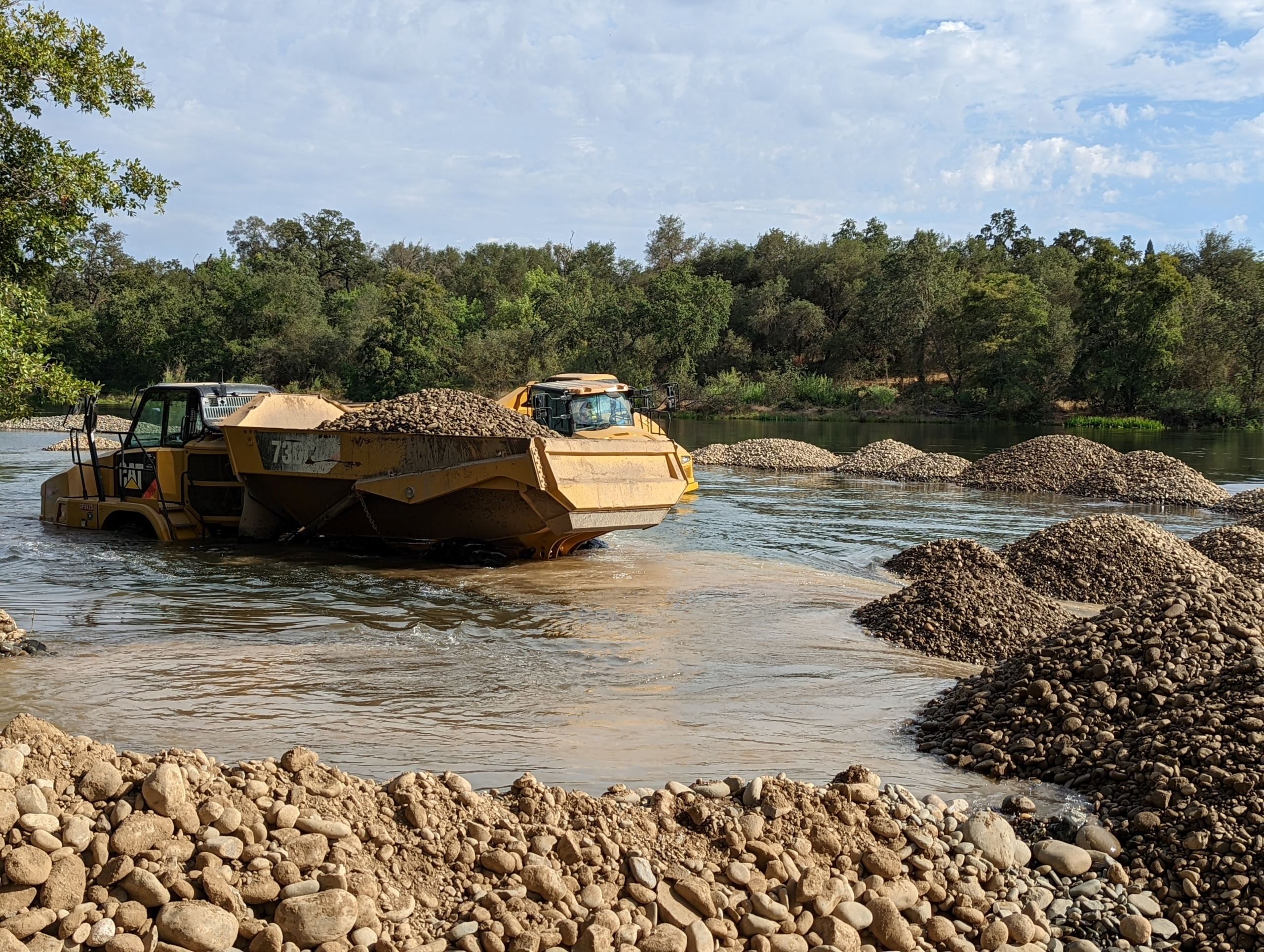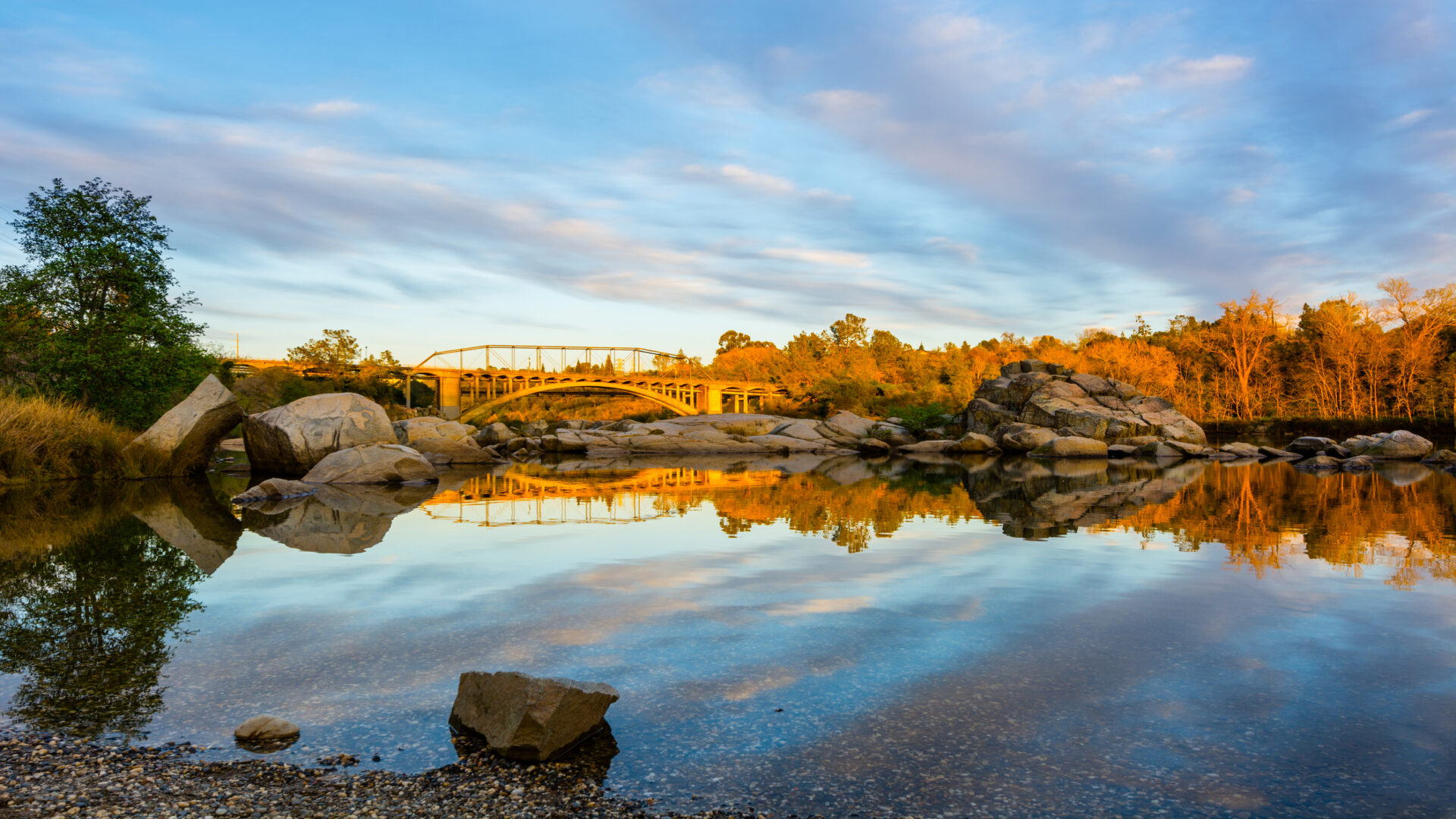
Quick Links
The Salmon Highway
Each year, thousands of anadromous fish swim through the Sacramento metropolitan region after surviving several years in the Pacific Ocean. These are our native fall-run Chinook salmon and steelhead trout. The term “anadromous” means they are born in freshwater rivers, migrate and spend part of their lives in the ocean, and return to their “natal” river to spawn and complete their life cycle.
Prime salmonid habitat is concentrated in the upper 10 miles below Nimbus Dam, and this is where the Water Forum targets habitat enhancements. Our fish historically utilized over 100 miles of mainstem and upper-watershed habitat before dams blocked their passage. Dams also trap vital sediment needed to replenish spawning areas.
For centuries, salmon and trout have been an important food and cultural resource for native Nisenan Maidu people. Native salmonids were historically more abundant. Preserving and restoring habitat for these fish is a priority for state and federal agencies and the Water Forum.
Enhancing habitat for salmon and steelhead in the Lower American River
The Lower American River is home to 43 fish species, including fall-run Chinook salmon and federally threatened Central Valley steelhead.
The Water Forum actively works to enhance habitat for salmon and steelhead in the Lower American River in partnership with federal, state and local agencies. In the past decade, the Water Forum and our partners have invested more than $7 million to create protected places for salmon and steelhead to reproduce and rear their young. This includes enhancing over 30 acres of spawning beds and 1.2 miles of side channels, which are prime rearing zones.
In 2020, the Water Forum was awarded $5 million in Prop 68 funding from the State for early implementation of the Statewide Voluntary Agreement process, which complements existing program funding while also amplifying the pace and scale of implementation.
Habitat Projects
In the near-term, the Water Forum is focusing on refining design, analysis, and implementing construction with a phased approach at 10 approved sites. In addition, the Water Forum is evaluating feasibility of other habitat enhancement sites on the river, continuing our efforts on multi-benefit projects such as Cordova Creek naturalization, and working to strengthen connections to organizations and stakeholders working to improve river corridor health on the Lower American River.
Salmon and Steelhead Habitat Enhancement
Each year, the Water Forum works to enhance habitat for salmon and steelhead to return to during their annual migration. Fall-run Chinook salmon migrate to the Lower American River as adults to spawn from October through December. In the egg-laying process, females create a “nest” (called a redd) in loose gravel in flowing water, depositing their eggs and then covering them up with more gravel. Once hatched, young salmon move to the river’s shallow, slower moving areas to find protection from predators and grow before swimming back out to the Pacific Ocean.
Water Forum teams carefully place tons of clean and sorted gravel in the river before fall-run salmon are triggered by cooling temperatures to spawn, and after the high spring and summer flows. In addition, they carve side channels or alcoves to create protected places for juvenile salmon to grow. Projects are designed to enhance habitat based on modeling that takes into account factors such as water velocity and depth.
Projects are undertaken yearly because quality spawning and rearing habitat for Chinook salmon and steelhead is limited on the Lower American River because of Nimbus and Folsom Dams. They replenish a resource that has historically been an important part of the Lower American River and its delicate ecosystem.
Learn more:
2024 Habitat Project at River Bend
2023 Habitat Project at Upper River Bend (Phase 1)
2022 Habitat Projects at Lower Sailor Bar and the Nimbus Basin
2021 Habitat Project at Ancil Hoffman Park
2019 Habitat Project at Upper Sailor Bar
Funding Partners
Habitat projects are made possible by grant funding from the California Natural Resources Agency (Proposition 68) and the Central Valley Project Improvement Act (U.S. Bureau of Reclamation) and through partnerships with:

Engagement
The Water Forum team and its members convene and engage in many important citizen working groups, forums and projects focused on the coequal objectives of water supply reliability and environmental health of the Lower American River. These include:
- Lower American River Task Force: Convened by the Water Forum and Sacramento Area Flood Control Agency, the Task Force’s major objective is to identify opportunities for improving existing flood control facilities and management strategies along the LAR while at the same time protecting and enhancing existing environmental and recreational resources in the American River Parkway.
- Fisheries and Instream Habitat (FISH) Working Group: The FISH Group functions as an informative venue for sharing timely fisheries and river science information and studies. Meetings are open to the public.
- American River Parkway Natural Resources Management Plan (Sacramento County Regional Parks): The plan was prepared as a guidance document for managing the natural resources of the American River Parkway. The Water Forum coordinates with Regional Parks on the plan’s implementation and monitoring.
- CVPIA – Science Integration Team: The U.S. Bureau of Reclamation and U.S. Fish and Wildlife Service established the Science Integration Team (SIT) to identify priorities for Chinook salmon, steelhead, and green and white sturgeon.
- Fire Safe Council (American River Parkway Foundation): The mission of the Fire Safe Council is to mitigate fire danger on the Parkway and protect natural habitat, infrastructure that resides on the Parkway and surrounding homes and businesses from fire.
Publications and Data
- Lower American River Salmonid Rearing Habitat Enhancement Project Identification and Prioritization Report, 2020: Provides a high-level overview of the lower American River to identify, develop initial concepts for, and prioritize potential rearing habitat enhancement sites.
- River Corridor Management Plan (RCMP): A comprehensive planning tool to manage the American River Parkway, including its fisheries, vegetation, wildlife habitat, flood control, and recreation values.
- Fisheries and Instream Habitat Plan (FISH plan): The plan outlines the most critical management and restoration actions needed to improve fisheries health and habitat for priority fish species in the Lower American River, including fall-run Chinook salmon and steelhead.
Fish Conditions
Technical Memos and Tools
- Fisheries and Health of the Lower American River: A Lookback at Summer 2021, Frequently Asked Questions, 2021
- Water Quality, Fish Community, and eDNA Monitoring During the 2021 Drought, Lower American River, CA, by Cramer Fish Sciences (prepared by Joseph Merz, Kirsten Sellheim, Jamie Sweeney, Bobbie Flores, Yekaterina Karpenko), updated 2021
- 2021 Critical Drought Conditions Temperature Management Planning Memo, prepared by Chris Hammersmark, PhD, PE (cbec, inc. eco engineering) and Paul Bratovich, MS (HDR, Inc.), 2021
- Chinook Salmon Early Lifestage Survival & Folsom Dam Power Bypass Considerations (Bratovich, et al, 2020
- Daily Chinook salmon early lifestage survival tool (Excel)
- The Central Valley Salmonid Story: Six Million Years in The Making, by Hilary Glenn, Stacie Fejtek, Jake Rennert, published in Frontiers for Young Minds, section Biodiversity
- Fisheries and In-Stream Habitat Management and Restoration Plan, 2019
Redd Counts
LAR Anadromous Fish Habitat Restoration Program Environmental Documentation
CEQA / NEPA
- Lower American River (LAR) Anadromous Fish Habitat Restoration Project Environmental Assessment Initial Study – June 2019
- LAR Anadromous Fish Habitat Restoration Project EA IS Appendices June 2019
- LAR Anadromous Fish Habitat Restoration Project NOA-NOI – June 2019
- Addendum No. 1 to the Mitigated Negative Declaration for the LAR Anadromous Fish Habitat Restoration Project
Clean Water Act Section 401
- WDID 5A34CR00696A2 401 Amendment 2 2020
- WDID-5A34CR00696A 401 Water Quality Cert Deviation 2020
- WDID-5A34CR00696A 401 Water Quality Cert 2017
- WDID-5A34CR00696A1_401 Amendment_2018
Clean Water Act Section 404
Corps Section 408 Permission / Central Valley Flood Protection Board
California Department of Fish and Wildlife
National Marine Fisheries Service
State Lands Commission
United States Fish and Wildlife Service
Wild and Scenic Rivers Act
Fisheries and In-Stream Habitat Management and Restoration Plan (FISH)
- FISH Plan Update, 2019
- FISH Plan Update, 2005
- FISH Plan Executive Summary, 2005

